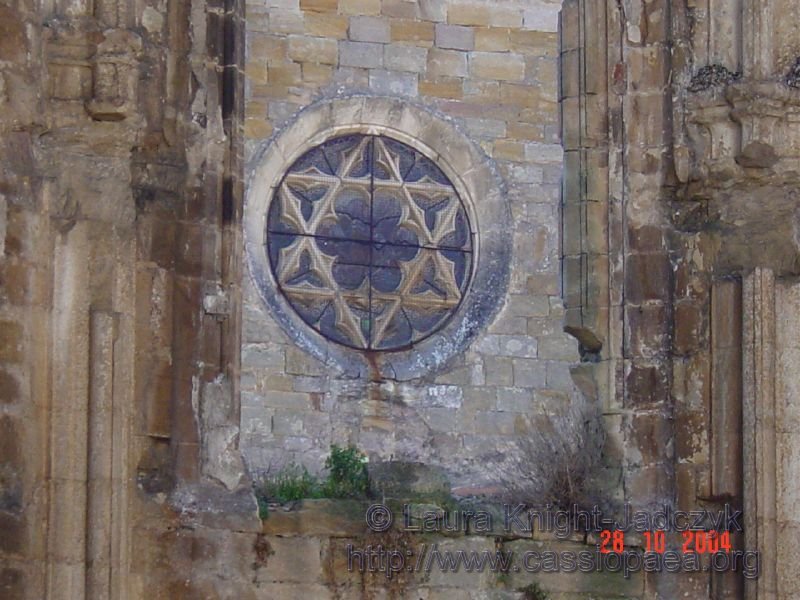The Quantum Future School Goes to Rennes-le-Chateau (7 of 68)
![[First]](bw_first.gif)
|
![[Prev]](bw_prev.gif)
|
![[Index]](bw_index.gif)
|
![[Next]](bw_next.gif)
|
![[Last]](bw_last.gif)
|

|
|
One of the more interesting features of the ruined cathedral in Alet-les-Bains is the fact that it has stained glass windows made in the form of the "Star of David" or Hexagram. The earliest known Jewish use of the hexagram was as a seal in ancient Israel (6th century B.C.E.) and then eight centuries later in a *synagogue frieze in Capernaum. But these early hexagrams may have been only ornamental designs; ironically, a swastika, another popular ancient motif, appears alongside the hexagram on the Capernaum synagogue wall. In the Middle Ages, hexagrams appear frequently on churches, but rarely in synagogues or on Jewish ritual objects. It was the *menorah that served as the primary Jewish symbol from antiquity until the post-Renaissance period, not the " Jewish star." Although scholars have attempted to trace the Star of David back to King David himself; to Rabbi Akiva and the Bar Kokhba ("son of the star") rebellion (135 C.E.); or to *kabbalists, especially Rabbi Isaac Luria (16th century), no Jewish literature or artifacts document this claim. All evidence suggests that the early use of the hexagram was limited to "practical Kabbalah." Kabbalistic Legends connect this symbol with the "Seal of Solomon," the magical signet signet ring used by King Solomon to control demons and spirits. The star inscribed on these rings was usually called the "Seal of Solomon." In addition to such legends about Solomon's ring, medieval Jewish magical texts spoke of a magic shield possessed by King David which protected him from his enemies. According to these texts, the shield was inscribed with the seventy-two letter name of God, or with Shaddai (Almighty) or angelic names, and was eventually passed down to Judah Maccabee. The 15th-century kabbalist, Isaac Arama, claimed that Psalm 67, later known as the "Menorah Psalm" because of its *seven verses (plus an introductory verse), was engraved on David's shield in the form of a menorah. Another tradition suggests that Isaiah 11:2, enumerating the six aspects of the divine spirit, was inscribed on the shield in the outer six triangles of the hexagram. In time, the hexagram replaced this menorah in popular legends about David's shield, while the five-pointed pentagram became identified with the Seal of Solomon. The hexagram was also widely regarded as a messianic symbol, because of a legendary connection with David, ancestor of the *Messiah. On Sabbath eve, German Jews would light a star-shaped brass *oil *lamp called a Judenstern (Jewish star), emblematic of the idea that Shabbat was a foretaste of the Messianic Age. The hexagram was also popular among the followers of Shabbatai Tzevi, the false messiah of the 17th century, because of its messianic associations. Among Jewish mystics and wonderworkers, the hexagram was most commonly used as a magical protection against demons, often inscribed on the outside of *mezuzot and on amulets. Another use of the hexagram in medieval times was as a Jewish printer's mark or heraldic emblem, especially in Prague and among members of the Jewish Foa family, who lived in Italy and Holland. In 1354, Emperor Charles IV of Prague granted the Jews of his city the privilege of displaying their own *flag on state occasions. Their flag displayed a large six-pointed star in its center. A similar flag remains to this day in the Altneuschul, the oldest synagogue in Prague. From Prague, the "Magen David" spread to the Jewish communities of Moravia and Bohemia, and then eventually to Eastern Europe. In 17th-century Vienna, the Jewish quarter was separated from the Christian quarter by a boundary stone inscribed with a hexagram on one side and a cross on the other, the first instance of the six-pointed star being used to represent Judaism as a whole, rather than an individual community. With Jewish emancipation following the French Revolution, Jews began to look for a symbol to represent themselves comparable to the cross used by their Christian neighbors. They settled upon the six-pointed star, principally because of its heraldic associations. Its geometric design and architectural features greatly appealed to synagogue architects, most of whom were non-Jews. Ironically, the religious Jews of Europe and the Orient, already accustomed to seeing hexagrams on kabbalistic amulets, accepted this secularized emblem of the enlightened Jews as a legitimate Jewish symbol, even though it had no religious content or scriptural basis. |
![[First]](bw_first.gif)
|
![[Prev]](bw_prev.gif)
|
![[Index]](bw_index.gif)
|
![[Next]](bw_next.gif)
|
![[Last]](bw_last.gif)
|